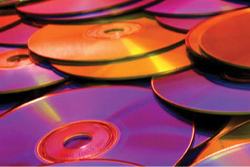Europe's online source of news, data & analysis for professionals involved in packaged media and new delivery technologies

DVD, Blu-ray discs first port of call to watch movies, TV shows, says NPD
Despite the much-trumpeted success of Netflix, many more people in the US are watching movies from their collection of DVDs and Blu-ray discs (59%), and as many watch movies on discs that they rent from kiosks (21%) as watch on a subscription VOD service (20%). In fact, it's twice as likely that consumers will be watching a TV series from a disc (30%) than via the most popular VOD options of subscription (16%) or free streaming (15%), according to Russ Crupnick, Senior VP, Industry Analysis at NPD Group, writing in his blog.
In the past 12 months (through March 2013), 44% of consumers purchased a movie on DVD or Blu-ray; 25% rented from a kiosk; 14% from VOD/Pay-per-View services; 5% bought a digital copy via EST (electronic sell-through), and only 4% bought a digital copy of a TV show.
Using data collected for their Entertainment Trends in America survey, Crupnick says that, in a three-month period (through March 2013), NPD found that 59% of respondents watched a movie on network TV - the same percentage that watch a movie on DVD or Blu-ray Disc. Another 44% watched a movie in a cinema; 36% from a digital video recorder (DVR); 21% from a rental kiosk; 20% from a free multichannel video programme distributor; 19% from a subscription Video-on-Demand (SVOD) service and 13% from a Pay-per-View VOD service.
How consumers watch TV shows? The same survey reveals that 81% watched it on network TV; 65% on cable TV; 42% watched the show they have recorded on their DVR or TiVo box; 30% watched it on DVD or Blu-ray discs; 18% via ad-supported VOD and Pay-per-View channel; 16% via SVOD; 15% from free streaming video service; 5% via Pay-per-View VOD; and 2% from Internet VOD rental service.
Packaged media is key to the economics of pre-recorded entertainment, says Crupnick. According to the Digital Entertainment Group, physical sell-through and rental of home video accounts for 72% of total home video spending, and that total factors in Netflix subscriptions. To compensate for a 10% decline in physical sell-through and rental, Electronic Sell-Through, Internet VOD, and PayTV VOD would need to grow by 50% based on today's expenditures.
Even the death of CD is exaggerated, the analyst points out. NPD's Annual Music Study 2012 shows that 35% of the Internet population bought a CD in 2012. Despite a precipitous drop in sales over the past decade, one in three consumers still buys CDs. CDs are the second most popular way consumers listen to music in cars, at 64%. Challenging misconceptions, fully 32% of teens (ages 13 to 19) bought a CD last year, and 67% listened to music on a CD.
"Now, 80% of teens listened to music on a video site such as YouTube or Vevo, and certainly streaming represents the future, but it's simply not accurate to say that physical music is irrelevant," says Crupnick. "Someday soon, perhaps, but it's not today - not when there are still 70 million buyers purchasing CDs (and, by the way, they pick up an average of about three CDs per year)."
Spotify listeners, who are considered very au courant in the music world, spend 90% more on CDs than do other music consumers, despite having (most of) the world's music library at their fingertips.
"Ignoring the bridge between physical and digital inevitably will launch you into the chasm, as there will be a vacuum created by the transition," concludes Crupnick. "In music, a $14 billion domestic CD business was never adequately replaced by a digital download business that captured $2.5 billion in annual sales. There's just less money today in streaming . . . at least, so far."
Story filed 27.06.13




















